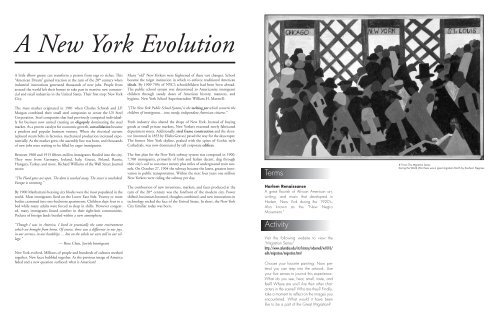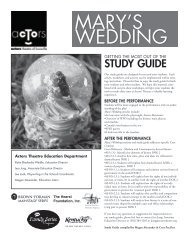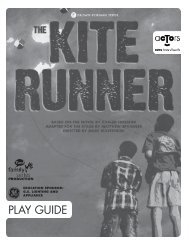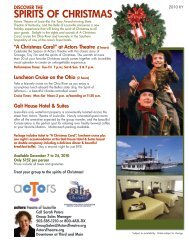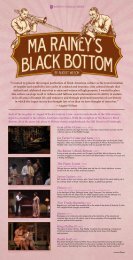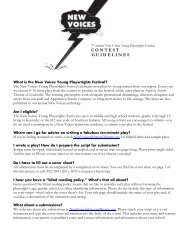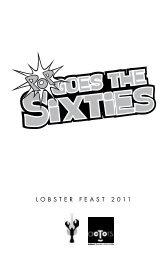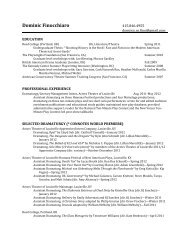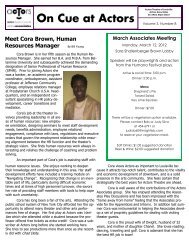Intimate Apparel Play Guide - Actors Theatre of Louisville
Intimate Apparel Play Guide - Actors Theatre of Louisville
Intimate Apparel Play Guide - Actors Theatre of Louisville
Create successful ePaper yourself
Turn your PDF publications into a flip-book with our unique Google optimized e-Paper software.
A New York Evolution<br />
A little elbow grease can transform a person from rags to riches. This<br />
“American Dream” gained traction at the turn <strong>of</strong> the 20 th century when<br />
industrial innovations generated thousands <strong>of</strong> new jobs. People from<br />
around the world left their homes to take part in massive new commercial<br />
and retail industries in the United States. Their first stop: New York<br />
City.<br />
Many “old” New Yorkers were frightened <strong>of</strong> these vast changes. School<br />
became the target institution in which to enforce traditional American<br />
ideals. By 1909 70% <strong>of</strong> NYC’s schoolchildren had been born abroad.<br />
The public school system was determined to Americanize immigrant<br />
children through steady doses <strong>of</strong> American history, manners, and<br />
hygiene. New York School Superintendent William H. Maxwell:<br />
The mass market originated in 1901 when Charles Schwab and J.P.<br />
Morgan combined their small steel companies to create the US Steel<br />
Corporation. Steel companies that had previously competed individually<br />
for business now united creating an oligopoly dominating the steel<br />
market. As a proven catalyst for economic growth, consolidation became<br />
a prudent and popular business venture. When the electrical current<br />
replaced steam belts in factories, mechanical production increased exponentially.<br />
As the market grew, the assembly line was born, and thousands<br />
<strong>of</strong> new jobs were waiting to be filled by eager immigrants.<br />
“[The New York Public School System] is the melting pot which converts the<br />
children <strong>of</strong> immigrants…into sturdy, independent American citizens.”<br />
Fresh industry also altered the shape <strong>of</strong> New York. Instead <strong>of</strong> buying<br />
goods at small private markets, New Yorkers swarmed newly fabricated<br />
department stores. Additionally, steel frame construction and the elevator<br />
(invented in 1853 by Elisha Graves) paved the way for the skyscraper.<br />
The former New York skyline, peaked with the spires <strong>of</strong> Gothic style<br />
Cathedrals, was now dominated by tall corporate edifices.<br />
Between 1900 and 1915 fifteen million immigrants flooded into the city.<br />
They were from Germany, Ireland, Italy, Greece, Poland, Russia,<br />
Hungary, Turkey, and more. Richard Williams <strong>of</strong> the Wall Street Journal<br />
wrote:<br />
“The Flood gates are open. The dam is washed away. The sewer is unchoked.<br />
Europe is vomiting.”<br />
By 1900 Manhattan’s heaving city blocks were the most populated in the<br />
world. Most immigrants lived on the Lower East Side. Twenty or more<br />
bodies crammed into one-bedroom apartments. Children slept four to a<br />
bed while many adults were forced to sleep in shifts. However congested,<br />
many immigrants found comfort in their tight-knit communities.<br />
Pockets <strong>of</strong> foreign lands bustled within a new atmosphere:<br />
“Though I was in America, I lived in practically the same environment<br />
which we brought from home. Of course, there was a difference in our joys,<br />
in our sorrows, in our hardships … but on the whole we were still in our village.”<br />
— Rose Chen, Jewish Immigrant<br />
New York evolved. Millions <strong>of</strong> people and hundreds <strong>of</strong> cultures meshed<br />
together. New faces bubbled together. As the previous image <strong>of</strong> America<br />
faded and a new question surfaced: what is American?<br />
The first plan for the New York subway system was composed in 1900.<br />
7,700 immigrants, primarily <strong>of</strong> Irish and Italian decent, dug through<br />
their city’s soil to construct twenty plus miles <strong>of</strong> underground train tunnels.<br />
On October 27, 1904 the subway became the latest, greatest innovation<br />
in public transportation. Within the next four years one million<br />
New Yorkers were riding the subway per day.<br />
The combustion <strong>of</strong> new inventions, markets, and faces produced at the<br />
turn <strong>of</strong> the 20 th century was the forefront <strong>of</strong> the modern city. Power<br />
shifted, businesses boomed, thoughts combined, and new innovations in<br />
technology rocked the face <strong>of</strong> the United States. In short, the New York<br />
City familiar today was born.<br />
Terms<br />
Harlem Renaissance<br />
A great flourish <strong>of</strong> African American art,<br />
writing, and music that developed in<br />
Harlem, New York during the 1920’s.<br />
Also known as the “New Negro<br />
Movement.”<br />
Activity<br />
Visit the following website to view the<br />
“Migration Series”<br />
http://www.columbia.edu/itc/history/odonnell/w1010/<br />
edit/migration/migration.html<br />
Choose your favorite painting. Now pretend<br />
you can step into the artwork. Use<br />
your five senses to journal this experience.<br />
What do you see, hear, smell, taste, and<br />
feel? Where are you? Are their other characters<br />
in the scene? Who are they? Finally,<br />
take a moment to reflect on the images you<br />
encountered. What would it have been<br />
like to be a part <strong>of</strong> the Great Migration?<br />
#1 from The Migration Series<br />
During the World War there was a great migration North by Southern Negroes.


